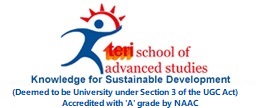
ANNOUNCEMENTS

| Date | News Title | Source |
| 18-July-2025 | 1 in 4 Indian married couples ... | The Indian Express |
| 23-June-2025 | Blended Learning: Driving educ... | The Pioneer |
| 22-June-2025 | All adults overweight in every... | |
| 21-June-2025 | TERI SAS Nurturing Global Sust... | The Interview World (Online) |
| 27-May-2025 | Eco-education trend grows: Sus... | India Today (Online- Education Desk) |
| 25-March-2025 | How water green credits can fu... | Hindustan Times (Opinion) |
| 23-February-2025 | Sustainable biz practices disc... | The Times of India (Online) |
| 21-February-2025 | Sangam fit for bath’, Enviro... | News9 (Online) |
| 12-February-2025 | A role for India in South-Sout... | The Hindu (Online) |
| 02-December-2024 | ICAR Findings Show 34% Decline... | ETV Bharat (Online) |
Gurgaon: The Haryana government has proposed it will declare areas around the Najafgarh lake as a wetland. It has submitted to the Centre an environmental management plan on how to protect the lake. The report will eventually be submitted to the National Green Tribunal (NGT).
According to the plan, Haryana will notify the area under Wetlands (Conservation and Management) Rules, 2017 and begin the process of demarcating it with geo-tagged pillars. It will also constitute a wetlands committee to oversee the entire process.
No construction, the plan proposes, will be allowed in the ‘hazard zone’. Haryana will also find alternative connectivity plans for settlements at the two ends of the lake, which will considerably reduce vehicular traffic, especially when migratory birds flock to the area.
Officials said once the area around the lake is notified as a wetland, it would give both Haryana and Delhi (some part of the waterbody is in NCT) equal powers to keep watch on prohibited activities, such as encroachment of any kind, disposal of waste and discharge of untreated effluents into the waterbody.
RK Chauhan, joint director in the environment and climate change department, said, “Yes, we have submitted a plan for the protection of the Najafgarh lake. It is a detailed report on how Haryana plans to manage the area.”
The plan, officials said, is divided into three parts — immediate action within a year in the first part, medium measures over the next two to three years in the next part and long-term steps in the last portion.
The Haryana government’s management plan was necessitated by an order of the NGT, which is hearing a petition filed by the Indian National Trust for Art and Cultural Heritage (INTACH) in 2018 for the protection of the lake.
The Delhi government, which is also a party to the case, submitted its plan in March this year. In June, the NGT had asked the Haryana chief secretary to be present with a management plan at the next hearing on October 4, but the government sought more time. The next hearing is on January 25.
Spread across 7 square kilometres, the Najafgarh lake is crucial for the region as it acts as a large aquifer for groundwater recharge. Many creeks from the Aravalis flow into the lake, and further into the Yamuna. According to the plan submitted by the government, the waterbody acts as a flood buffer, helps treat water and regulate temperature, and is a biodiversity hotspot.
Ritu Rao, a research scholar at the Teri School of Advanced Studies who is working on urban waterbodies’ sustainability, said, “The Najafgarh lake area should definitely be declared as a wetland. Only tertiary treated sewage water should be discharged into the lake. The government should also declare a no-construction zone up to the high flood level (contour 212.5 manak) as the area is prone to liquefaction (in the event of an earthquake, the ground starts behaving like any liquid, causing buildings in the area to tilt or even collapse). It is a wetland by nature and comes under seismic zone IV.”
Plot No. 10, Institutional Area, Vasant Kunj, New Delhi - 110 070, India.
Tel. +91 11 71800222 (25 lines).
Website : www.terisas.ac.in
Email id : registrar@terisas.ac.in
© Copyright © 2025, TERI SAS, All rights reserved.
Visitors No.: 44719461 Since 2023


